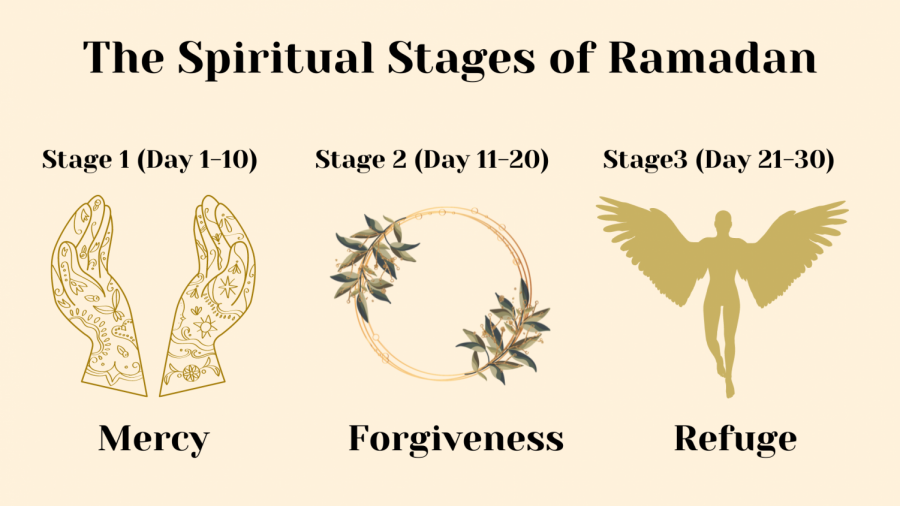Ramadan: Everything You Need To Know
Learn the basics of Ramadan and Islamic traditions through this guide.
April 30, 2021
RAMADAN MUBARAK!
My name is Alefiya Presswala and I’m a junior at EBHS. I am also a Muslim student who is currently fasting for Ramadan!
Through this ‘online journal’ of sorts, I’ll be sharing the history and significance of Ramadan, the benefits of fasting, including my own experiences and tips, some recipes, and the perspectives of other Muslim students.
Feel free to give me any suggestions on things I should include or ask questions on any content I publish at [email protected]
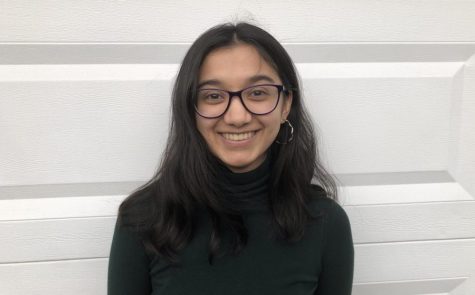
*I would like to add a disclaimer that I am only speaking about MY experiences and MY family’s traditions/ways of practicing. I do not represent or speak for the Muslim community*
Ramadan: The Basics
Not even water?
WHAT IS RAMADAN?
In simple words, Ramadan is the holiest month in the Islamic calendar. Muslims believe that in 610 AD, the angel Jibril (Gabriel) appeared to the Prophet Muhammad and revealed the Holy Book, or the Quran, to him. This revelation, called the Night of Power or Laylatul Qadr, is said to have occurred during the month of Ramadan. Laylatul Qadr is considered the holiest night of the entire Islamic year- many believe that prayers completed on this night are the most beneficial and will bring you the most blessings. Ramadan is a time for Muslims to build a closer relationship with God (Allah) and ask for forgiveness. According to Islamic belief, Ramadan is a time in which Allah opens the door to Paradise and chains up Shaytaan (the devil).
WHEN IS RAMADAN?
Islam follows the lunar calendar, in which each month lasts for a lunar cycle. Because of this, Ramadan starts about 11 days earlier each year. In fact, in 2030, there will be two Ramadans in one year! For different sects of Islam, the lunar calendar may differ by 1 or 2 days. For example, I am a Shia Muslim and started fasting a day earlier than Sunni Muslims.
WHAT DOES ONE DO DURING RAMADAN?
In general, as a way to commemorate the revelation of the Quran, Muslims fast from sunrise to sunset for the full month of Ramadan. Fasting is one of the fundamental principles of Islam. For Muslims, fasting includes not only refraining from eating, but also refraining from drinking anything or taking medicine orally. No– not even water is allowed. Other things that allow you to break your fast include (but are not limited to): intentional vomiting, menstruation, and losing large amounts of blood.
Muslims who are pregnant, menstruating, or have other health issues are not required to fast, but missed fasts should be made up before the next Ramadan.
If you want to wish your Muslim friends a happy Ramadan, say Ramadan Mubarak or Ramadan Kareem!
A Day In The Life Of A Fasting Student
Get an inside look into the daily routine of a fasting student.
SUHOOR (SEHRI)
The day starts off in the early AM for suhoor- or sehri, as many people call it. Suhoor is the meal consumed by Muslims in the early morning before fasting. The goal of suhoor is to eat a mini breakfast so that fasting does not hinder your everyday responsibilities. For me, hydration is more of a problem than hunger- every morning, I have a few mini cucumbers and slices of watermelon, along with many glasses of water.
Each day, suhoor starts and ends a few minutes later. In general, it starts around 4:00-4:20 AM. After suhoor ends, fasting officially begins and it is time to pray fajr namaz.
NAMAZ (nuh-maaz)
Namaz is the prayers that Muslims complete five times every day. As mentioned before, Ramadan is about building a closer relationship with Allah, so prayers are extra important during this month. My dad always says, “Fasting without prayer is just starving yourself.”
But before prayers can begin, one must complete wudu. Wudu is both a spiritual and physical preparation for your prayers- it’s almost like a purification process. Wudu includes rinsing your arms, face, hands, feet, etc while performing dua, another type of prayer. Muslims believe that cleanliness- mentally and physically- is an important factor in becoming close with God, Without wudu, your prayers are invalid, and there are many things that can break your wudu, such as using the bathroom, passing gas, sleeping, and light bleeding. If your wudu accidentally breaks during namaz, you must re-complete wudu and start your namaz over.
Fajr (fuj-ur)
Technically, the Islamic day begins at sunset, so fajr would be considered the third prayer of the day, but starting from midnight, it is the first prayer. Fajr, meaning dawn, is usually in the early morning around 5:00-6:00 AM, but times can vary. It is the shortest of all the five prayers.
Zuhr (zo-har) and Asr (asar)
Zuhr refers to midday prefers, after the sun passes its highest point. This can usually be completed around 12:00-1:00 PM, around lunchtime. Zuhr usually ends around 3 PM. Asr refers to the later part of the afternoon, ending around 5:00-6:00 PM. Shia Muslims allow for Zuhr and Asr to be completed together, right after one another.
Maghrib (Mug-rib)
In an Islamic day, Maghrib prayer is technically the first prayer. Maghrib refers to sunset prayer, and for fasting Muslims, this is when we finally get to break our fast. Many believe that Maghrib is the most meaningful prayer and it is a terrible thing to miss it. For Shia Muslims, Maghrib prayers also have a limited time window, around 5-10 minutes.
Isha (ish-aa)
Isha prayer, called the night prayer, can be completed right after Maghrib according to Shia doctrine, although the window lasts until midnight.
IFTAR
Iftar is the meal that Muslims eat after sunset to break their fast. It is one of the most significant points of the day during Ramadan. Traditionally, to break their fast, Muslims will eat a date and drink water. Then, many families have a large spread of dishes from all different food groups. One of my favorite things to drink during iftar is rose milk.
My family has been so lucky to receive food from the mosque in East Brunswick almost every night, along with our own mini dishes on the side.
With the next chapters, I’ll be sharing some simple recipes that my family and I have made during Ramadan. Stay tuned!

Chicken Kebabs
Try out this easy chicken kebabs recipe for an extra kick of flavor at your dinner table!
These chicken kebabs are quick, easy, and fun to make. Grab a family member and get started on this colorful treat! You won’t regret it!
Ingredients:
-2 lb mince chicken thigh
-1 yellow onion
-1 small beet
-5-6 garlic cloves, minced
-2-3 tbsp parsley
-1 large jalapeno diced
-1 egg
-½ cup breadcrumbs
-1 tsp garlic powder
-Salt and pepper
Steps:
1. In a bowl, grate the onion and beet (make sure to squeeze out as much water as you can and discard)
2. Add the minced garlic cloves, parsley, jalapenos, and egg and mix altogether
3. Add the breadcrumbs, garlic powder, minced chicken thigh, and salt and pepper to taste. Mix altogether.
4. Cover the bowl and let sit in the fridge for 30 minutes. Preheat the oven to 400 degrees F.
5. After 30 minutes, take the bowl out of the fridge. Wet your hands, then scoop some chicken into your hands and form a cylindrical ball shape. Shape the chicken into kebabs, using two skewers at a time.
6. Load the skewers onto a flat pan. Bake in the oven for 45 minutes (or however long the kebabs take to cook fully) at 400 degrees F. Remember to flip them every 15 minutes.
7. After cooking, brush the kebabs with melted butter and garnish with parsley.
8. Enjoy!
*Optional: Serve these kebabs with cucumber yogurt sauce!
1. Grate half a cucumber and drain all excess liquid.
2. Add 1 cup of plain Balkan style yogurt (Greek is fine too).
3. Add 2-3 tbsp parsley, juice from ½ lemon, 3-4 minced garlic cloves, salt to taste, and a splash of water. Mix altogether and serve with kebabs!
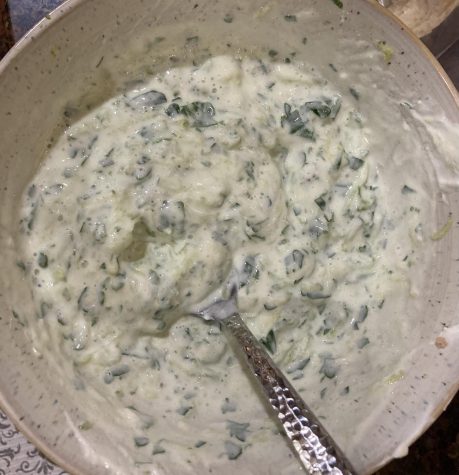
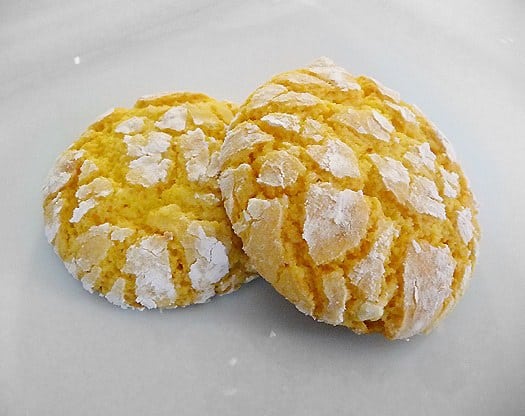
Lemon Cookies
Learn how to make one of my favorite desserts!
I love trying new things and I’m always on the search for new dessert recipes, but somehow, I always come back to these lemon cookies. These cookies are a huge hit in my house: they’re simple to make, have a wonderful flavor, and stay soft for days!
Ingredients:
-1 cup white sugar
-½ cup butter, softened
-2 tbsp fresh lemon zest
-2 eggs
-1 tbsp fresh lemon juice
-½ tsp vanilla extract
-1 ¾ cups all-purpose flour
-1 ½ tsp baking powder
-¼ tsp salt
-¼ cup powdered sugar
Steps:
1. Cream sugar, butter, and lemon zest together in a large bowl using an electric mixer until light and fluffy. This should take about 2-3 minutes. *Make sure your butter is at room temperature for this! Otherwise this process will be really difficult*
2. Combine eggs, lemon juice, and vanilla extract in a cup. Beat into sugar mixture on low speed.
3. Whisk flour, baking powder, and salt together in a bowl. Add to mixture slowly on low speed until just combined. *Make sure not to overbeat this mixture- it’s really sticky!*
4. Cover the dough and let chill in the fridge for 30 minutes.
Preheat the oven to 350 degrees F. Line 2 large baking sheets with parchment paper.
5. Form dough into balls and roll each in powdered sugar. Place each ball onto baking sheets and lightly press down on each ball with fingers.
6. Bake in the oven for around 11-12 minutes.
7. Enjoy!
*Optional: I like to add a little bit of yellow food coloring to my cookies to make them more colorful*

Cheesy Garlic Bread
This garlic bread is sure to leave your mouth watering and wanting for more.
Whether you’re making something for Iftar or you’re looking for a quick snack, these cheesy garlic bread slices are the way to go! Keep scrolling for a recipe that only takes 15-20 minutes to make and results in a warm, savory dish.
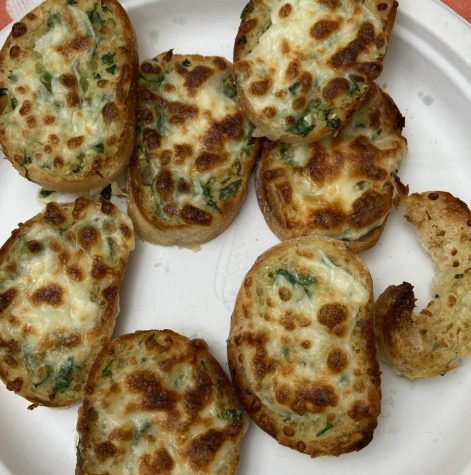
Ingredients:
– 1 Baguette loaf
– 1 stick butter (room temperature)
– 2-3 tbsp parsley
– 2-3 tbsp garlic cloves
– 1 tbsp chives
– Shredded mozzarella
Steps:
1. Combine all ingredients (except baguette and mozzarella) in a bowl and mash together until fully combined
2. Cut baguette bread into slices, spread butter onto slices, and sprinkle mozzarella onto each slice.
3. Broil in the oven at 350 degrees F. Keep a watch on the bread to see if the cheese is melted. Once the cheese is melted enough to your liking, take the bread out of the oven.
4. Serve while hot and enjoy!
An EBHS Insight Into Ramadan
Read about the traditions of 3 Muslim students during Ramadan.
Over the past week, I interviewed three Muslim juniors at EBHS: Sima Abu Doush, Basmala Soltany, and Ajab Shakir. We talked about what Ramadan means to them and their favorite parts of this holy month. Scroll down to see their responses!
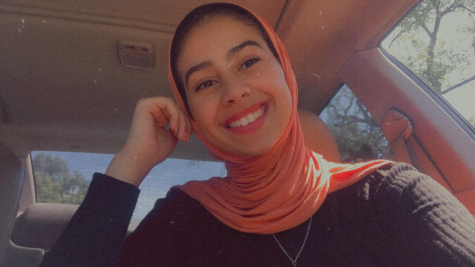
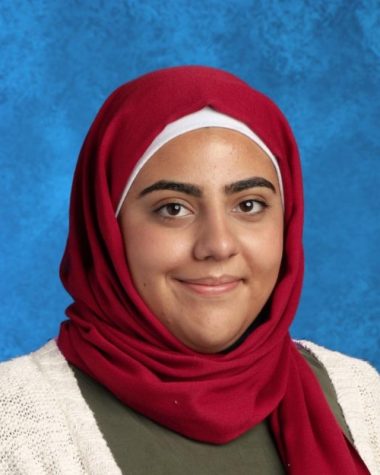
Q: WHAT DOES RAMADAN MEAN TO YOU? WHAT IS YOUR FAVORITE PART OF RAMADAN?
SIMA ABU DOUSH: Ramadan is a month where I get to focus and become closer to my religion and remember those who are less fortunate. My favorite part of Ramadan is seeing everyone come together as a whole and participate in this holy month. I really enjoy the time spent with family and the good deeds that are done.
BASMALA SOLTANY: Ramadan is the one month that I look forward to every year. It is a month of gathering of family members and giving back to those in need. It teaches me patience and to feel empathy for others. My favorite part of Ramadan has to be the decorations since it is a tradition in my house to decorate every year. It makes me feel like I am back in my home country where decorations were in every house and street.
AJAB SHAKIR: Ramadan is to celebrate our religion, honor our ancestors, and showcase our tolerance and patience in the world. My favorite part of Ramadan is definitely Eid. I’ve loved Ramadan ever since I was a kid because it’s an excuse to gather up with friends and family and eat our hearts out after we break our fast!
Q: IS THERE ANYTHING YOU MISS ABOUT RAMADAN PRE-COVID?
SAD: Covid has affected many of our lives and made it difficult to complete many of our daily tasks. During Ramadan, Covid has affected how often my family and I got to go to the mosque because there is a limit to how many people can be there.
BS: The one thing I miss most about Ramadan is the gatherings in houses and mosques. Because of Covid and social distancing, I have been seeing less of my friends and family during Ramadan and I wish that could change.
AS: I really miss going to the mosque. I think a huge part of Ramadan is the happiness it brings when you’re able to gather with your loved ones at the end of a long day, to just honor our religion and eat good food! Because of Covid-19, our mosque has been reduced to a max capacity, and unfortunately, with my grandparents and parents at home, I haven’t been able to go out much.
Q: DO YOU AND YOUR FAMILY HAVE ANY SPECIAL TRADITIONS FOR RAMADAN OR EID? ARE THERE ANY FOODS YOU LIKE TO COOK?
SAD: During Ramadan, my family and I like to decorate the house with Ramadan decorations that we keep up till Eid. During Eid, we usually get to see family and go out to eat dinner. During Ramadan, we have a special dessert we like to make called Ataif. Ataif are an Arabic dessert usually made from yeasted pancakes stuffed with an aromatic filling of toasted walnuts mixed with cinnamon and sugar. They are gently fried till golden brown and served drizzled with sugar syrup. One of my favorite dishes to have for Iftar is vegetable stuffed grape leaves.
BS: My family has a tradition of making the Egyptian dish Mahshi for the first day of Ramadan. As well as eating dates with milk before Iftar. For Eid, my family makes Eid Biscuits which are homemade biscuits decorated in a special way.
AS: I love biryani on Eid. We usually have a barbecue with my close family and friends but the night of, my grandma makes biryani and it’s the perfect end to Ramadan.
Q: WHAT’S ONE THING YOU WISH NON-MUSLIM PEOPLE KNEW ABOUT RAMADAN?
SAD: One thing I wish non-Muslims knew about Ramadan is the true meaning behind Ramadan and not just see it as a month of fasting.
BS: I wish that non-Muslims knew more accurate facts about Ramadan and the true reasoning behind us fasting, and not only to starve which some people might think and that it is rewarding. That ultimately, Ramadan is also a celebration.
AS: I wish that all people were aware that Ramadan isn’t a forceful month of hunger and fasting isn’t something that’s meant to torture anyone. It’s a beautiful month of religious holidays and it’s meant to teach us the appreciation of what we have. It makes us grateful for what we have around us, in terms of food and people! It teaches us tolerance and the importance of our ancestors’ efforts.
Hopefully these students were able to give you more of an insight about the significance of Ramadan and what it looks like in the EBHS community. Stay tuned for the next chapter, where I go into detail about MY personal experiences with fasting.
The Phases of Fasting
Read about the physical and spiritual phases of Ramadan.
To many, Ramadan can feel very overwhelming or difficult. But worry not! As draining as fasting can be at the beginning of the month, studies show that fasting naturally gets easier as the month goes on- and there are plenty of health benefits.
Let’s break it down into four phases.
PHASE 1
The first few days of fasting are usually the hardest- one might experience headaches, dehydration, nausea, dizziness, or extreme hunger. During this first phase, your body is just beginning the cleansing process. Your blood sugar and blood pressure will most likely also drop.
PHASE 2
The transition into Phase 2 occurs after the first full week of fasting. During this phase, the body, especially the digestive system, is slowly starting to get more accustomed to fasting. More specifically, the digestive system can focus on cleansing the body. The organs also begin a cleansing process.
PHASE 3
The third phase of fasting occurs about halfway through Ramadan. By this time, you should have a lot more energy and be able to concentrate on your daily tasks better. Fasting will probably be a lot easier as well. Overall, your body’s healing process is a lot faster and your skin, body, and organs are all experiencing a detox.
PHASE 4
The last phase of fasting is during the last 10 days of Ramadan. Your body and mind are both fully accustomed to fasting- you should be able to function normally as you would if you were not fasting. Patience and concentration will have increased.
These are the physical phases of fasting. But as I’ve mentioned before, fasting during Ramadan is not only about just not eating/drinking – it’s also about practicing patience, kindness, restraint, etc. Take a look at the infographic below to get an idea of what the three spiritual stages, or ashra, look like.
MY EXPERIENCES
Overall, my experience with fasting followed the four physical stages of Ramadan. While the cycle did start over for me because of menstruation and days where I didn’t feel well, I generally became accustomed to fasting within a week or so. As a junior taking multiple AP classes and starting to prepare for college, I also genuinely appreciated the extra time I got from not having to sit down for meals. Personally, I didn’t mind fasting while also going to school- there was an extra sense of clarity and concentration that this Ramadan provided. However, there were some bad days where I was extremely tired, dehydrated, and lethargic.
Here are some tips I picked up along the way to help me stay hydrated and active while fasting:
-During Suhoor, drink a lot of water and eat hydrating foods like cucumbers and watermelon
-Eat foods like these during Iftar as well
-Take cold showers!
-Wash your face to refresh yourself
-If and when going out in the sun, wear a hat and/or lighter colors
Do try to go outside once a day, even if it’s just for 15 minutes
-If you’re going to take a nap, make sure it’s only for about 90 minutes
I find that longer naps, combined with no water and food for the day can actually make me feel worse, as well as more lethargic
Watching TV or staring at a screen for a prolonged period of time also makes me feel this way
-Use your time productively: don’t spend time trying to calculate how many more hours until Iftar, instead spend that time doing something creative or helpful for someone else
-GO TO SLEEP EARLY!!
The worst feeling is getting only a few hours of sleep before Suhoor and then having to get through the entire school day the next morning
And last but not least:
-Take a break when needed.
Everybody’s body is different, everyone has a different experience with Ramadan and fasting and Islam. It’s okay if you’re not feeling well one day and you decide you can’t fast. It’s okay to not feel ‘connected’ spiritually with Islam all the time. It’s okay to just do you and take your time with this process.
Eid Al-Fitr
Eid Mubarak!
Translating to “festival of breaking the fast” in Arabic, Eid Al-Fitr is an Islamic celebration that begins the day after Ramadan ends. The celebration takes place over 1-3 days and traditions include, but are not limited to: special Eid prayers, gift giving, charity, and large feasts with ethnic delicacies.
Every year, my family makes a dish called sheer khurma, a vermicelli pudding made with milk, sugar, and different types of nuts. Along with sheer khurma, the other treat gracing our dinner thaali (a large silver platter) was a sticky date cake, topped with a warm butterscotch sauce. (Here is the recipe if you’d like to try it out: https://sticky-date-cake).
Another part of Eid is gift-giving. Eidi or eidiyah is a gift given from older relatives to younger children. The most common type of eidi is money given in an envelope. It is also customary for Muslims to donate to charitable causes they believe in.
Eid Al-Fitr is a very special celebration for Muslims, so we like to get dressed up for this holiday. I don’t own much cultural clothing, but my sister and I were very excited to get henna, or mehendi, done on our hands this year.
Take a look at this gallery below for a small look into my family’s Eid celebration.




